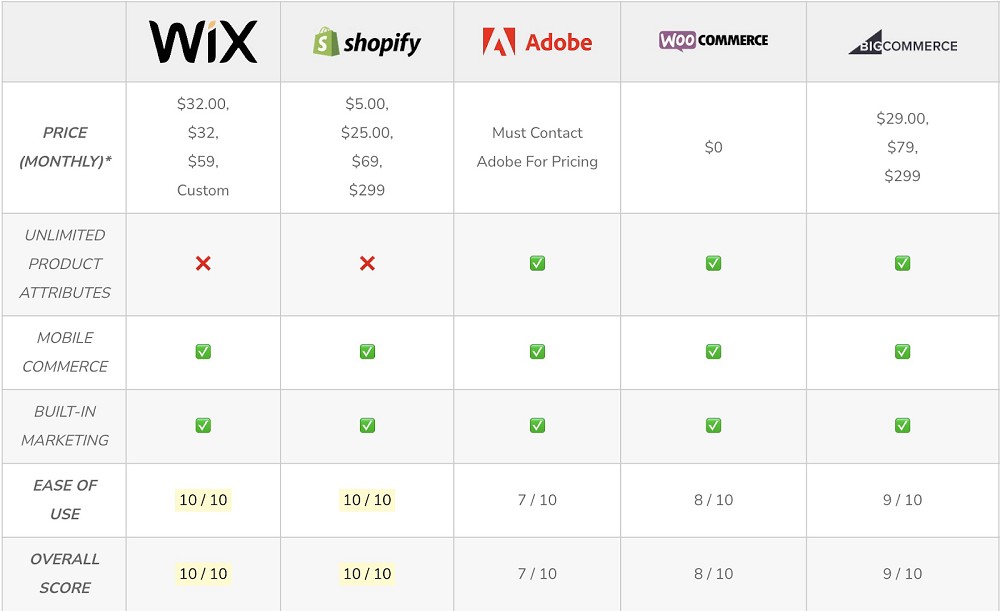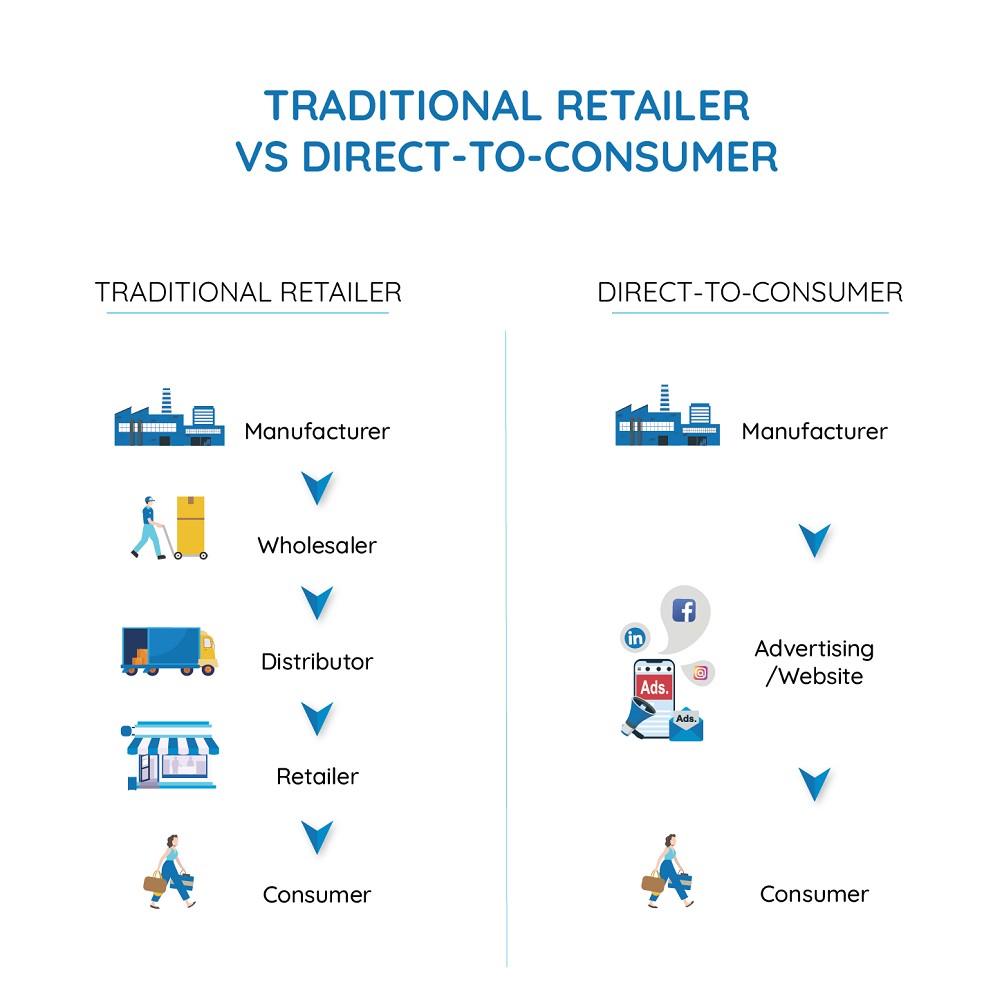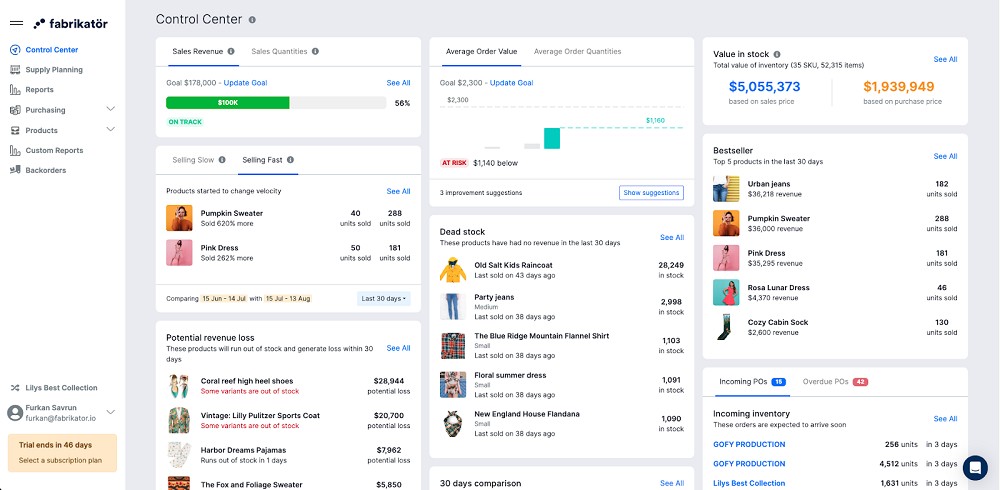Credit: D2CVille
Read the full guide here!
Hello! Whether you're on the hunt for your own DTC brand or seeking to up your game with an existing one, this is the go-to guide for you!
Drawing insights from over 20 podcasts featuring accomplished DTC entrepreneurs, conversations with experts, and hours of consultation, we've crafted a comprehensive resource for anyone keen on delving into the world of DTC.
Covering everything from platform selection to digital marketing strategies, supply chain management, and emerging trends, this guide has you covered!
No more words—let's dive straight in!
Introduction to DTC
What is DTC?
DTC (also referred to as D2C) stands for Direct-to-Consumer, and it refers to a business model where a company sells its products or services directly to consumers without the need for intermediaries like retailers or wholesalers.
In a traditional retail model, products typically pass through various middlemen before reaching the end consumer. DTC, on the other hand, allows businesses to reach their customers directly through online sales channels, cutting out the middle steps in the distribution process.

Key advantages of the DTC model.
The Direct-to-Consumer (DTC) model offers several key advantages for businesses:
- Branding Control: DTC allows complete control over brand image and messaging.
- Data Insights: Direct sales provide valuable customer data, enabling personalized marketing and improved products.
- Profit Margins: Cutting out middlemen often leads to higher profit margins for DTC brands.
- Agility: DTC brands can quickly respond to market trends and adapt to changing consumer demands.
- Direct Communication: Building relationships with customers fosters loyalty and allows prompt responses to feedback.
- E-commerce Advancements: Technology and e-commerce platforms make it easier for brands to establish and manage online channels.
Setting Up Your DTC Business
Setting up your Direct-to-Consumer (DTC) business involves several crucial steps. Think of it as laying the foundation for a successful venture.
Choosing the right product or niche.
Choosing the right product or niche for your DTC business is crucial. Here's a starting guide:
- Passion and Interest: Align with your passion for sustained commitment.
- Market Research: Identify trends, analyze competitors, and find unmet needs.
- Target Audience: Define and understand your audience to ensure market viability.
- Unique Selling Proposition (USP): Develop a compelling differentiator for your product.
- Sustainability and Trends: Consider eco-friendliness and stay updated on industry trends.
- Scalability: Assess growth potential without compromising quality.
- Profitability: Evaluate manufacturing costs, pricing, and profit margins.
- Regulatory Considerations: Understand and comply with relevant regulations.
- Adaptability to E-commerce: Consider packaging, logistics, and online appeal.
Building a strong brand identity.
Building a strong brand identity is crucial for your DTC business:
- Clearly define your brand's mission and values.
- Design a memorable logo and consistent visuals.
- Choose a cohesive color palette.
- Develop a unique brand voice and tagline.
- Share your brand story and values.
- Maintain a consistent online presence.
- Encourage customer relationships and advocacy.
- Deliver consistent quality in products/services.
- Stay adaptable to market trends.
- Regularly monitor and refine your brand identity.
Check out Indeed’s article on how to build a strong brand identity here!
Selecting the right Ecommerce Platform
Ecommerce platforms are software solutions that facilitate the creation and management of online stores, allowing businesses to sell products or services on the internet. These platforms provide a range of tools and features to manage various aspects of the online sales process. Here are some popular e-commerce platforms:
Shopify
- User-friendly and versatile.
- Offers a range of customizable templates.
- Integrated payment options and a variety of apps through its app store.
Use this link to start your business on Shopify.
WooCommerce
- WordPress plugin for creating e-commerce sites.
- Highly customizable and scalable.
- Leverages the power of WordPress for content management.
Use this link to start your business on WooCommerce.
Magento by Adobe
- Open-source platform with robust features.
- Suitable for larger enterprises and complex online stores.
- Offers high customization and flexibility.
Use this link to start your business on Magento.
BigCommerce
- Cloud-based platform with a focus on scalability.
- Provides a range of built-in tools for marketing and analytics.
- Suitable for growing businesses.
Use this link to start your business on BigCommerce.
Wix eCommerce
- Drag-and-drop website builder with e-commerce capabilities.
- Offers a variety of templates for easy customization.
- Well-suited for small to medium-sized businesses.
Use this link to start your business on Wix eCommerce.
Comparison of popular ecommerce platforms.
There are many ecommerce platforms available today, each with its own strengths and weaknesses. In this comparison, we will look at some of the most popular ecommerce platforms and compare them based on various factors, including pricing, features, ease of use, customization options, and more.
Here is a useful table comparing the platforms:

Source: Codeinwp
Digital Marketing Strategies for DTC Brands
Digital marketing is indispensable for any DTC out there, as the digital world is your only touchpoint to your customers. To achieve success in digital marketing, there are several steps you need to take.
And we already got you covered!
Check out our resources: Everything you need to know about content marketing in 2024, and the DTC Guide to Growth Marketing (Use this to download the free growth marketing guide).

Social media marketing for DTC
Do you want to have a successful social media marketing strategy? Then,
Incorporate a robust social media marketing strategy to enhance your DTC business. Utilize popular platforms such as Facebook, Instagram, and Twitter to connect with your target audience.
Develop engaging content that resonates with your brand, leveraging visuals, videos, and interactive elements.
Implement targeted advertising campaigns to reach specific demographics, and encourage user-generated content to foster community engagement. Regularly analyze social media analytics to refine your approach and maximize impact.
Content marketing and SEO
Elevating your online presence requires a strategic blend of content marketing and SEO. Here's how you can do that:
Content Marketing
- Create Valuable Content:
- Develop content that addresses your audience's needs and interests.
- Craft engaging blog posts, articles, infographics, and videos.
- Define Your Brand Voice:
- Establish a consistent brand voice across all content.
- Infuse personality to make your brand memorable.
- Content Calendar Planning:
- Develop a content calendar for consistent and timely publishing.
- Align content with seasonal trends, product launches, or industry events.
- Some great tools for content calendar planning are Monday and ClickUp
- Promote User Engagement:
- Encourage user interaction through comments, shares, and feedback.
- Leverage social media platforms to amplify your content reach.
- Visual Appeal:
- Use compelling visuals to enhance content attractiveness.
- Incorporate infographics, images, and videos for a multimedia experience.
SEO
- Keyword Research:
- Conduct thorough keyword research to understand search intent.
- Incorporate relevant keywords naturally into your content.
- Some tools for doing keyword research are Ahrefs and Google Search Console
- Optimize On-Page Elements:
- Ensure meta titles, descriptions, and headers are optimized for search engines.
- Use descriptive URLs and alt tags for images.
- Mobile Optimization:
- Optimize your website for mobile devices to enhance user experience.
- Google prioritizes mobile-friendly sites in search rankings.
- Quality Backlinks:
- Build high-quality backlinks from reputable websites.
- Foster collaborations and partnerships within your industry.
- Page Loading Speed:
- Optimize your site for fast loading to improve user experience.
- Compress images and leverage browser caching.
- Regular Content Updates:
- Keep your content fresh and relevant through regular updates.
- Update outdated information and repurpose content when possible.
By seamlessly integrating content marketing and SEO strategies, you can not only enhance your online visibility but also provide valuable content that resonates with your target audience. This synergy contributes to improved search engine rankings, increased organic traffic, and a stronger digital presence overall.
Supply Chain and Fulfillment

Traditional retailer vs. DTCVisual source: Parcelperform.com
Efficient inventory management
Efficient inventory management is pivotal for the success and sustainability of any business. Check out our guide for the best inventory management tips.
Here's an exploration of the key reasons highlighting its importance:
Cost Control
- Avoid Overstocking: Efficient inventory management prevents excessive stock, reducing costs associated with storage and potential obsolescence.
- Minimize Stockouts: By maintaining optimal stock levels, businesses avoid the costs and potential revenue loss linked to stockouts.
If you're looking for producing overseas, cost control is everything! Learn more here!
Cash Flow Optimization
- Reduced Holding Costs: Keeping only necessary inventory levels frees up capital that can be invested elsewhere, contributing to improved cash flow.
- Faster Turnover: A well-managed inventory ensures products move quickly, allowing the business to generate revenue and recover costs faster.
Customer Satisfaction
- Timely Order Fulfillment: Efficient inventory practices enable timely order processing and fulfillment, enhancing customer satisfaction.
- Accurate Stock Availability: Businesses can provide accurate information on product availability, minimizing disappointment for customers.
Demand Planning
- Data-Driven Decision-Making: Comprehensive inventory data aids in forecasting and planning, allowing businesses to align stock levels with expected demand.
- Adaptability: Businesses can respond swiftly to changes in market demand and trends, optimizing product offerings.
Do you want to learn more about the best supply chain management tools: Check out our list here!
Improved Supplier Relationships
- Streamlined Ordering: Accurate demand forecasting facilitates better communication with suppliers, leading to more precise ordering and reduced lead times.
- Negotiation Leverage: Businesses with a clear understanding of their inventory needs can negotiate better terms with suppliers.
Enhanced Efficiency and Accuracy
- Automation: Leveraging technology automates inventory tracking, minimizing human errors and improving overall efficiency.
- Real-Time Monitoring: Businesses can monitor inventory levels in real-time, facilitating quick decision-making.
What tool do we offer? Of course, Fabrikatör Virtual Inventory Assistant!
Fabrikatör assists you in making better inventory decisions for your store by:
- Streamlining operations
- Maximizing profits by forecasting demand
- Automating pre-orders
- Ensuring customer satisfaction by integrating your supply chain with your Shopify storefront and Klaviyo.

In essence, efficient inventory management is a linchpin for achieving financial stability, meeting customer expectations, adapting to market dynamics, and positioning the business for sustained growth. Its impact extends across various facets of operations, making it a fundamental aspect of successful business management.
A successful inventory management cannot be achieved without successful fulfillment operations. Check out our guide on how to find the best 3PL for your operations!
Design, Analytics, Customer Service, and More
Website Design and User Experience:
Creating an effective website design and ensuring a positive user experience (UX) is crucial for the success of your DTC business.
- Simplicity is Key ??: Opt for a clean and intuitive design with clear navigation.
- Mobile-Friendly Design ??: Ensure a responsive layout for seamless viewing on all devices.
- Speed Matters ?: Optimize for fast loading times by compressing images and using CDNs.
- Clear CTAs ??: Place compelling and easily clickable call-to-action buttons.
- Consistent Branding ??: Maintain a uniform look with consistent colors, fonts, and logos.
- Visual Appeal ??: Use high-quality images and engaging content for product displays.
- Streamlined Checkout ??: Simplify the checkout process and offer multiple payment options.
- User-Friendly Forms ??: Keep forms simple and implement auto-fill options.
- Engaging Content ??: Include compelling product descriptions and user-generated content.
- Search Functionality ??: Implement a robust search bar with filters for quick product discovery.
- Security Assurance ??: Clearly communicate website security measures to build trust.
- Accessibility ?: Ensure your website is accessible and follows WCAG guidelines.
- Social Media Integration ??: Integrate social sharing buttons and display social media feeds.
- A/B Testing ??: Conduct A/B testing to optimize design elements for better conversion.
- User Behavior Analysis ??: Use analytics tools to track user behavior and identify areas for improvement.

Data Analytics and Insights
Importance of data-driven decision-making.
Informed strategies are crucial in the DTC landscape, and data plays a pivotal role by providing insights into customer behavior. This allows for strategic planning and the implementation of targeted marketing efforts. As a a result of that, data-driven personalization appears as a huge topics in today's DTC lanscape.
Likewise, the optimization of campaigns is facilitated through the analysis of metrics, ensuring a better return on investment (ROI). A deep dive into customer data enhances customer understanding, enabling businesses to tailor their offerings based on preferences.
The adaptability of a DTC business is strengthened as swift adjustments can be made in response to real-time data, ensuring agility in a dynamic market.
Additionally, resource optimization becomes achievable through efficient allocation based on thorough data analysis, preventing wastage and enhancing overall operational efficiency.
Key metrics to track for DTC success.
- Conversion Rate: Measure the percentage of website visitors converting into customers to assess campaign effectiveness.
- Customer Lifetime Value (CLV): Predict the value a customer brings over their entire relationship with your brand.
- Churn Rate: Track the rate at which customers discontinue engagement, providing insights into customer satisfaction.
- Average Order Value (AOV): Understand the average amount spent by customers per transaction to guide pricing and promotions.
- Customer Acquisition Cost (CAC): Evaluate the cost of acquiring a new customer compared to their lifetime value.
- Return on Advertising Spend (ROAS): Assess the effectiveness of advertising campaigns by measuring the return on investment.
Implementing analytics tools and dashboards.
Choose the Right Tools: Selecting the most appropriate analytics tools aligned with your goals and scale is foundational. The choice of tools should resonate with the specific requirements and objectives of your business.
Integrate E-commerce Analytics: Tailor analytics solutions to the unique nuances of e-commerce platforms. This customization ensures the capture of relevant data specific to the intricacies of your online business, providing actionable insights.
Customize Dashboards: Developing customized dashboards is instrumental in gaining quick and clear insights into key metrics. Tailor these dashboards to focus on the specific performance indicators essential for informed decision-making.
Automation for Real-Time Data: Integrating automated reporting systems into your analytics framework is essential for real-time data availability. This automation empowers timely decision-making by ensuring that insights are current and reflective of the dynamic business environment.
By prioritizing data-driven decision-making and diligently tracking essential metrics, DTC businesses can navigate the dynamic landscape with agility, refine strategies, and optimize performance for sustained success. The implementation of the right analytics tools and customized dashboards further empowers businesses to unlock the full potential of their data, fostering a culture of continuous improvement and adaptability.
Customer Service Excellence
Building a responsive customer support team.
A cornerstone of customer service excellence is establishing a responsive customer support team. Cultivating a team that is not only knowledgeable but also empathetic to customer needs ensures a positive and helpful interaction. Providing ongoing training and fostering a customer-centric culture within the team are essential components in creating a support system that excels in addressing customer queries and concerns promptly.
Leveraging chatbots and automation.
In the digital age, leveraging technology becomes paramount for efficient customer service. Integrating chatbots and automation streamlines routine inquiries, providing instant responses and freeing up human resources for more complex issues. Smartly implemented, these tools enhance efficiency, offering customers quick resolutions while improving overall service accessibility.
Handling returns and managing customer feedback.
Navigating returns and managing customer feedback are integral parts of ensuring customer satisfaction. Streamlining the returns process with clear policies and efficient communication not only resolves issues swiftly but also contributes to building trust. Actively seeking and managing customer feedback provides valuable insights for continuous improvement. A robust feedback loop allows businesses to adapt strategies, address pain points, and enhance overall service quality.
Case Studies and Success Stories:
Real-world examples of successful DTC brands
- Dollar Shave Club: Renowned for its subscription-based razor and grooming products, Dollar Shave Club focuses on providing quality at an affordable price.
- Obvi: Obvi is a brand that specializes in health and wellness products, particularly supplements.
- Lavender Hill Clothing: Based in the UK, Lavender Hill specializes in sustainable basics for women.
- OZARKE: Based in Houston, Texas, OZARKE specializes in modern and minimalist home design.
- Mate Toothbrush: Based in Germany, the brand specializes in soft electronic toothbrushes.
Trends and Future of DTC
Emerging trends in DTC marketing and sales.
We had a wonderful chat with Jake Madoff, who is the Head of Growth Marketing at Everytable. Jake says the trends that will shape the future of DTC will be:
AI Integration
Anticipate improved AI capabilities in literally everything, from ad creation to content generation process by 2024.
Multitouch Marketing
Diversify efforts across platforms like Meta, search engines, YouTube, and TikTok for a holistic brand presence and increased awareness.
Attribution Measurement
Emphasize ongoing importance of attribution tools, highlighting Meta's upcoming click-based attribution and the role of content in marketing.
Community Building
Invest in community-building for lasting consumer loyalty, utilizing strategies like newsletters and emails to foster shared values. For more tips on this, check out D2CVille's content!
Personal Branding
Prioritize continual investment in social media presence and personal branding for sustained success, combining efforts for a powerful brand image.
Technologies shaping the future of DTC
For learning more about the technologies, why don’t you check out our DTC tools list? ??
Well, we hope you got some DTC wisdom if you reach this point! Check out our other content to keep up with what's happening in the DTC market, some more DTC wisdom, and more!